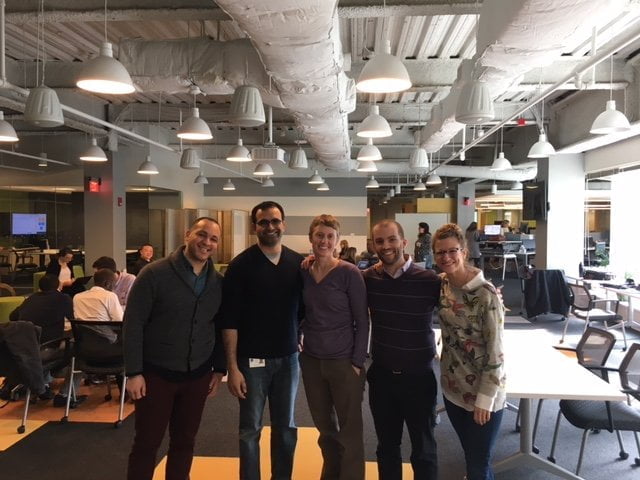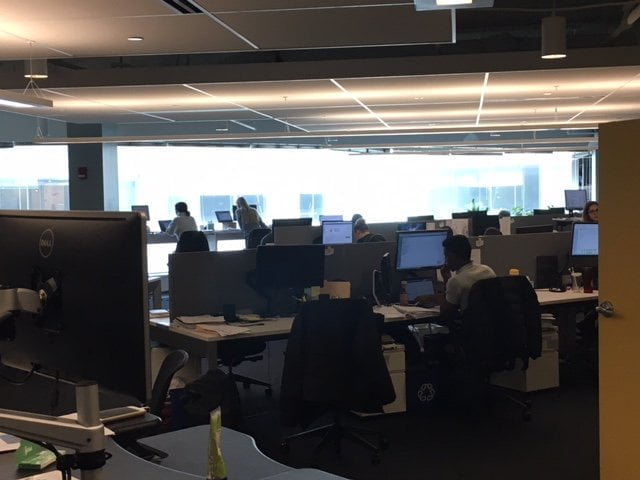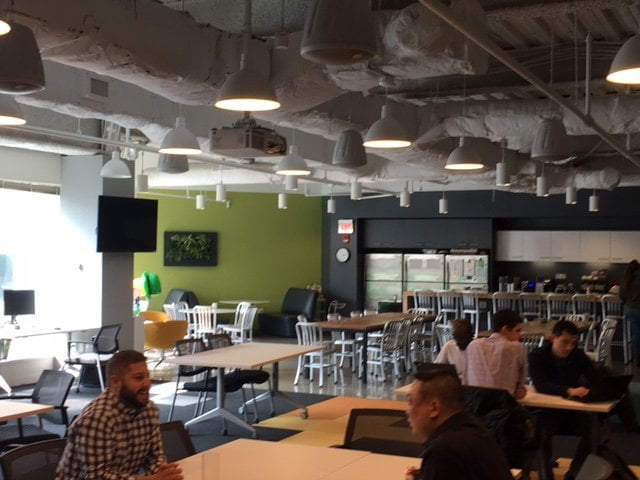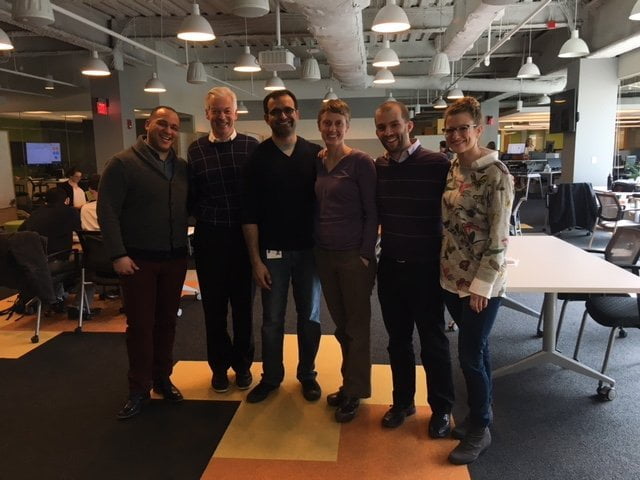Better Than Most is a regular feature of The Business of Giving examining the best places to work among social good businesses and nonprofit organizations.
Denver: One of the very best nonprofit organizations in the world just so happens to have one of the very best corporate cultures. It is the Bridgespan Group which helps mission-driven organizations and philanthropists to advance their learning and accelerate their impact. Their Boston headquarters is in Copley Square and I visited there recently to hear from the staff about some of the unique and exceptional aspects of their work culture.

Derek: When we engage with our clients, we engage in what are called case teams. So there is typically a partner that will manage the main client, and then there’s a manager on the case, and then there are a number of consultants or associate consultants. And the case team will also be supported by operations teams and marketing and knowledge and different pieces as well. But in that core case team, really the essence is that you’re able to split up the work that you’re doing and give people ownership over different pieces of that work. And that case team will typically extend over the course of six or eight months of the engagement, and then you’ll go your separate ways and then maybe come back together when you’re on another case with another client.
Jen: I mean I really believe since day one that our leadership team walks the talk. You see it from the compassion and kindness and generosity even in terms of just giving people credit for the work that they do. So you’ll see at company meetings, Jeff or one of our leaders will stand up and talk about an important meeting that they were at and he’ll give credit to the junior person in the room if they’re there. Or when he comes back and he’s telling a story about the great work that someone perceived that Bridgespan did for them, he gives the credit to the team and he’ll name the people in the room. And I think that really sets a standard and I think people feel really good about that.
Mandy: I also have found it to be an incredible opportunity for personal growth. So I didn’t know much at all about the world of consulting before I entered it, and it just has turned out to be a great fit in terms of stretching me and pushing me to play different roles that I’ve played here at Bridgespan to interact with different organizations, different kinds of leaders; to be stretched but in a way that we’re being supported and coached, so I’m not being thrown out to dry by I am being pushed to see what I can do, to see what I can achieve.

Sridhar: That change, that dynamism, I think, creates an organizational culture, where to some degree, there’s this sense of dissatisfaction with the way the world is and trying to do everything you can to change it. So the famous Robert Kennedy metaphor, “ripples of hope,” echoes around this place, that everyone sees their work as being those ripples of hope. And they want to see those ripples be bigger and bigger over time. And so there is this sense of dissatisfaction of continually pushing to the sense of how can we do this better, how can we make an even greater impact than what we did before? That is both challenging, that is dynamic, that is at times stressful, but also incredibly motivating, incredibly enabling and empowering, and ultimately is the reason why we do the work.
Rayshawn: I think another thing that really resonates for me is the mission of the work we do. I know that whether I am working however many hours in that week, it’s going to be for a client that I care about, it’s going to be with people that I care deeply about, and it’s going to be pushing towards a mission that I feel deeply aligns with my personal mission. As Mandy mentioned, being able to align with work that is really focused on breaking cycles of intergenerational poverty is really exciting and not something you get to do everywhere.
Mandy: One of the ways that we think about growth at Bridgespan is about the formal training we give. We also provide a lot of informal training on-the-job training in the context of our case teams, in the context of peer colleagues or mentors. But the formal training is something that is really unique in that we’ve been able to take, in my mind, the best of two worlds. So we are able to benefit from the excellent training that Bain & Company, which sort of incubated us in our early days and is still a very close partner. They enable us to send our staff to their trainings, their consultant trainings. So essentially, our staff are able to access sort of world-class training, very tailored to the consulting skill set and common challenges. And we have a complimentary suite of Bridgespan training, so the areas in which the tool kit is different or where we diverge from how Bain does their work, we’re able to provide that. But that combination is just an incredible value from my own personal experience, from seeing, at this point, hundreds of people over the years go through Bain training. It’s a real asset and one of the ways in which we help people grow.

Rayshawn: We’ve also got a phenomenal annual review process where people are receiving input from their direct supervisors. People are also receiving input from their direct reports, and all of that comes together. I’m an associate consultant and what happens is all of the partners and managers actually get together in a big room, which is a fish bowl, so you know when they’re all in there, and they talk about, “Here’s what this person is doing well. Here’s what this person needs to continue working on.” Then you’ve got a consensus reviewer who pulls all of that together and delivers the message to you. So, not only do you have a lot of people thinking about this really intently, but you’ve got somebody that’s able to say, “Here are the key messages you need to hear,” which makes it so much easier than focusing on “here’s what I need to do to improve.”
Jen: There’s a variety of ways of being involved at Bridgespan, and we have what we call Extra 10% Committees and you can join as many as you want. Generally, people join one or two. But it’s extra 10% because it’s really like you get your job done and then you come join this committee and pitch in to the culture. But I’m on one that’s called “The Way We Work,” and a lot of that has to do with how we work in this open design space and making sure that all seating is equally desirable and accessible, speaking into the whole non-hierarchical atmosphere we strive to have here.
Sridhar: And so I think we’ve made conscious organizational investments to increase the amount of communication, increase the amount of collaboration in part because our theory of the way the work happens is that it does not happen by an individual themselves. It happens with all of us as teams. It happens as an organization. And so that culturally is important to who we are. It’s culturally important. I think to folks who succeed here, succeed within that kind of construct. They’re able to be collaborative. They’re able to work well with their colleagues, to share, to learn. We’ve got about 30 whiteboards on wheels that get wheeled around left, right and center. Things get drawn and erased all the time. That sense of creating something through a collaborative environment is quite important.
Mandy: I’m proud of the way in which Bridgespan strives to be an inclusive organization. So over 50% of our partner group is women. That’s unusual to look at any senior partner group at a professional services entity and see that. We’ve scored 100 on the HRC corporate equality index since we’ve been participating, which is on the order of 10 years or so we’ve been doing that. We have well-established group has for folks who are part-time, who need to spend some time with family, need that flexibility at some point on an ongoing basis in their careers. And we’re deeply focused on building our diversity along racial and socio-economic lines, both in terms of certainly the demographics of our staff, bringing diversity of thought and experience, but also increasingly on how we think about that diversity in our work.
Rayshawn: One of the things I’ve really appreciated about Bridgespan is that we have been completely transparent about the fact that we’re on a journey here. We don’t think that we are the best in the field when it comes to diversity, equity, and inclusion. But what we are willing to say is that we are working really hard at this and we’re willing to be uncomfortable with the fact that it’s going to be hard to get there. And being uncomfortable in that way is a hard thing to do and it takes not only folks raising their hand and saying, “I want to work on this,” but it also takes people in senior leadership actually modeling the way and being able to say, “This is something we care deeply about.”

Denver: I want to extend my thanks to Liz London who has been a real good friend of the show for organizing my visit and to those who participated, Jen Driggs, Derek Brine, Mandy Taft-Pearman, Rayshawn Whitford and Sridhar Prasad. You can listen to the podcast, read a copy of the transcript, and see pictures of the participants on the Bridgespan offices simply by going to denverfrederick.wordpress.com
The Business of Giving can be heard every Sunday evening between 6:00 p.m. and 7:00 p.m. Eastern on AM 970 The Answer in New York and on iHeartRadio. You can follow us @bizofgive on Twitter, @bizofgive on Instagram and at http://www.facebook.com/BusinessOfGiving

